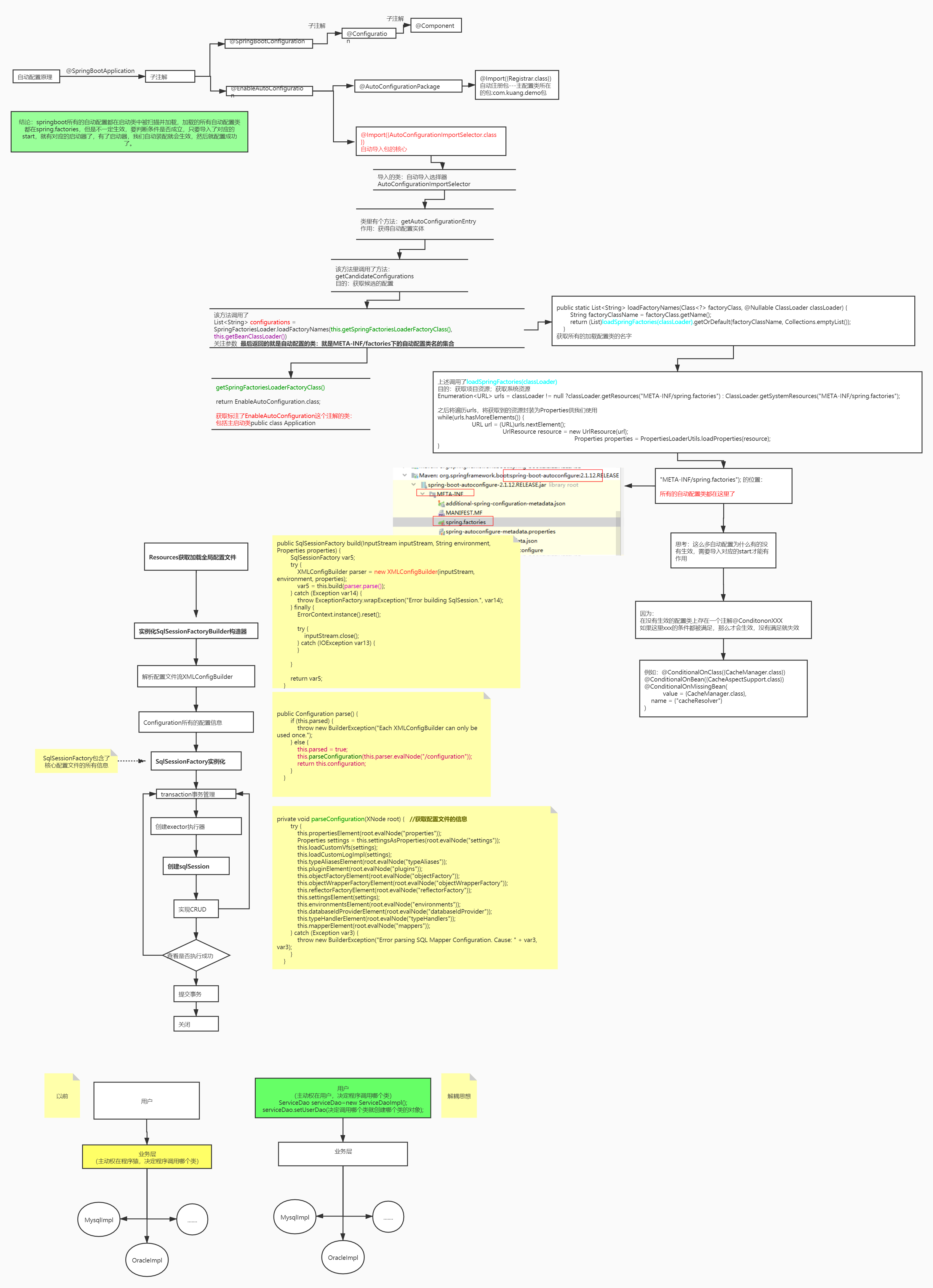SpringBoot高頻面試題
Springboot的優點
- 內建servlet容器,不需要在伺服器部署 tomcat。只需要將專案打成 jar 包,使用 java -jar xxx.jar一鍵式啟動專案
- SpringBoot提供了starter,把常用庫聚合在一起,簡化複雜的環境設定,快速搭建spring應用環境
- 可以快速建立獨立執行的spring專案,整合主流框架
- 準生產環境的執行應用監控
SpringBoot 中的 starter 到底是什麼 ?
starter提供了一個自動化設定類,一般命名為 XXXAutoConfiguration ,在這個設定類中通過條件註解來決定一個設定是否生效(條件註解就是 Spring 中原本就有的),然後它還會提供一系列的預設設定,也允許開發者根據實際情況自定義相關設定,然後通過型別安全的屬性注入將這些設定屬性注入進來,新注入的屬性會代替掉預設屬性。正因為如此,很多第三方框架,我們只需要引入依賴就可以直接使用了。
執行 SpringBoot 有哪幾種方式?
- 打包用命令或者者放到容器中執行
- 用 Maven/Gradle 外掛執行
- 直接執行 main 方法執行
SpringBoot 常用的 Starter 有哪些?
- spring-boot-starter-web :提供 Spring MVC + 內嵌的 Tomcat 。
- spring-boot-starter-data-jpa :提供 Spring JPA + Hibernate 。
- spring-boot-starter-data-Redis :提供 Redis 。
- mybatis-spring-boot-starter :提供 MyBatis 。
本文已經收錄到Github倉庫,該倉庫包含計算機基礎、Java基礎、多執行緒、JVM、資料庫、Redis、Spring、Mybatis、SpringMVC、SpringBoot、分散式、微服務、設計模式、架構、校招社招分享等核心知識點,歡迎star~
如果存取不了Github,可以存取gitee地址。
Spring Boot 的核心註解是哪個?
啟動類上面的註解是@SpringBootApplication,它也是 Spring Boot 的核心註解,主要組合包含了以下 3 個註解:
-
@SpringBootConfiguration:組合了 @Configuration 註解,實現組態檔的功能。
-
@EnableAutoConfiguration:開啟自動設定的功能,也可以關閉某個自動設定的選項,如關閉資料來源自動設定功能: @SpringBootApplication(exclude = { DataSourceAutoConfiguration.class })。
-
@ComponentScan:Spring元件掃描。
自動設定原理
SpringBoot實現自動設定原理圖解:

在 application.properties 中設定屬性 debug=true,可以在控制檯檢視已啟用和未啟用的自動設定。
@SpringBootApplication是@Configuration、@EnableAutoConfiguration和@ComponentScan的組合。
@Configuration表示該類是Java設定類。
@ComponentScan開啟自動掃描符合條件的bean(新增了@Controller、@Service等註解)。
@EnableAutoConfiguration會根據類路徑中的jar依賴為專案進行自動設定,比如新增了spring-boot-starter-web依賴,會自動新增Tomcat和Spring MVC的依賴,然後Spring Boot會對Tomcat和Spring MVC進行自動設定(spring.factories EnableAutoConfiguration設定了WebMvcAutoConfiguration)。
@Target(ElementType.TYPE)
@Retention(RetentionPolicy.RUNTIME)
@Documented
@Inherited
@AutoConfigurationPackage
@Import(EnableAutoConfigurationImportSelector.class)
public @interface EnableAutoConfiguration {
}
EnableAutoConfiguration主要由 @AutoConfigurationPackage,@Import(EnableAutoConfigurationImportSelector.class)這兩個註解組成的。
給大家分享一個Github倉庫,上面有大彬整理的300多本經典的計算機書籍PDF,包括C語言、C++、Java、Python、前端、資料庫、作業系統、計算機網路、資料結構和演演算法、機器學習、程式設計人生等,可以star一下,下次找書直接在上面搜尋,倉庫持續更新中~
@AutoConfigurationPackage用於將啟動類所在的包裡面的所有元件註冊到spring容器。
@Import 將EnableAutoConfigurationImportSelector注入到spring容器中,EnableAutoConfigurationImportSelector通過SpringFactoriesLoader從類路徑下去讀取META-INF/spring.factories檔案資訊,此檔案中有一個key為org.springframework.boot.autoconfigure.EnableAutoConfiguration,定義了一組需要自動設定的bean。
# Auto Configure
org.springframework.boot.autoconfigure.EnableAutoConfiguration=\
org.springframework.boot.autoconfigure.admin.SpringApplicationAdminJmxAutoConfiguration,\
org.springframework.boot.autoconfigure.aop.AopAutoConfiguration,\
org.springframework.boot.autoconfigure.amqp.RabbitAutoConfiguration,\
org.springframework.boot.autoconfigure.batch.BatchAutoConfiguration,\
org.springframework.boot.autoconfigure.cache.CacheAutoConfiguration,\
這些設定類不是都會被載入,會根據xxxAutoConfiguration上的@ConditionalOnClass等條件判斷是否載入,符合條件才會將相應的元件被載入到spring容器。(比如mybatis-spring-boot-starter,會自動設定sqlSessionFactory、sqlSessionTemplate、dataSource等mybatis所需的元件)
@Configuration
@ConditionalOnClass({ EnableAspectJAutoProxy.class, Aspect.class, Advice.class,
AnnotatedElement.class }) //類路徑存在EnableAspectJAutoProxy等類檔案,才會載入此設定類
@ConditionalOnProperty(prefix = "spring.aop", name = "auto", havingValue = "true", matchIfMissing = true)
public class AopAutoConfiguration {
@Configuration
@EnableAspectJAutoProxy(proxyTargetClass = false)
@ConditionalOnProperty(prefix = "spring.aop", name = "proxy-target-class", havingValue = "false", matchIfMissing = false)
public static class JdkDynamicAutoProxyConfiguration {
}
@Configuration
@EnableAspectJAutoProxy(proxyTargetClass = true)
@ConditionalOnProperty(prefix = "spring.aop", name = "proxy-target-class", havingValue = "true", matchIfMissing = true)
public static class CglibAutoProxyConfiguration {
}
}
全域性組態檔中的屬性如何生效,比如:server.port=8081,是如何生效的?
@ConfigurationProperties的作用就是將組態檔的屬性繫結到對應的bean上。全域性設定的屬性如:server.port等,通過@ConfigurationProperties註解,繫結到對應的XxxxProperties bean,通過這個 bean 獲取相應的屬性(serverProperties.getPort())。
//server.port = 8080
@ConfigurationProperties(prefix = "server", ignoreUnknownFields = true)
public class ServerProperties {
private Integer port;
private InetAddress address;
@NestedConfigurationProperty
private final ErrorProperties error = new ErrorProperties();
private Boolean useForwardHeaders;
private String serverHeader;
//...
}
實現自動設定
實現當某個類存在時,自動設定這個類的bean,並且可以在application.properties中設定bean的屬性。
(1)新建Maven專案spring-boot-starter-hello,修改pom.xml如下:
<?xml version="1.0" encoding="UTF-8"?>
<project xmlns="http://maven.apache.org/POM/4.0.0"
xmlns:xsi="http://www.w3.org/2001/XMLSchema-instance"
xsi:schemaLocation="http://maven.apache.org/POM/4.0.0 http://maven.apache.org/xsd/maven-4.0.0.xsd">
<modelVersion>4.0.0</modelVersion>
<groupId>com.tyson</groupId>
<artifactId>spring-boot-starter-hello</artifactId>
<version>1.0-SNAPSHOT</version>
<dependencies>
<dependency>
<groupId>org.springframework.boot</groupId>
<artifactId>spring-boot-autoconfigure</artifactId>
<version>1.3.0.M1</version>
</dependency>
<dependency>
<groupId>junit</groupId>
<artifactId>junit</artifactId>
<version>3.8.1</version>
</dependency>
</dependencies>
</project>
(2)屬性設定
public class HelloService {
private String msg;
public String getMsg() {
return msg;
}
public void setMsg(String msg) {
this.msg = msg;
}
public String sayHello() {
return "hello" + msg;
}
}
import org.springframework.boot.context.properties.ConfigurationProperties;
@ConfigurationProperties(prefix="hello")
public class HelloServiceProperties {
private static final String MSG = "world";
private String msg = MSG;
public String getMsg() {
return msg;
}
public void setMsg(String msg) {
this.msg = msg;
}
}
(3)自動設定類
import com.tyson.service.HelloService;
import org.springframework.beans.factory.annotation.Autowired;
import org.springframework.boot.autoconfigure.condition.ConditionalOnClass;
import org.springframework.boot.autoconfigure.condition.ConditionalOnMissingBean;
import org.springframework.boot.autoconfigure.condition.ConditionalOnProperty;
import org.springframework.boot.context.properties.EnableConfigurationProperties;
import org.springframework.context.annotation.Bean;
import org.springframework.context.annotation.Configuration;
@Configuration
@EnableConfigurationProperties(HelloServiceProperties.class) //1
@ConditionalOnClass(HelloService.class) //2
@ConditionalOnProperty(prefix="hello", value = "enabled", matchIfMissing = true) //3
public class HelloServiceAutoConfiguration {
@Autowired
private HelloServiceProperties helloServiceProperties;
@Bean
@ConditionalOnMissingBean(HelloService.class) //4
public HelloService helloService() {
HelloService helloService = new HelloService();
helloService.setMsg(helloServiceProperties.getMsg());
return helloService;
}
}
-
@EnableConfigurationProperties 註解開啟屬性注入,將帶有@ConfigurationProperties 註解的類注入為Spring 容器的 Bean。
-
當 HelloService 在類路徑的條件下。
-
當設定 hello=enabled 的情況下,如果沒有設定則預設為 true,即條件符合。
-
當容器沒有這個 Bean 的時候。
(4)註冊設定
想要自動設定生效,需要註冊自動設定類。在 src/main/resources 下新建 META-INF/spring.factories。新增以下內容:
org.springframework.boot.autoconfigure.EnableAutoConfiguration=\
com.tyson.config.HelloServiceAutoConfiguration
"\"是為了換行後仍然能讀到屬性。若有多個自動設定,則用逗號隔開。
(5)使用starter
在 Spring Boot 專案的 pom.xml 中新增:
<dependency>
<groupId>com.tyson</groupId>
<artifactId>spring-boot-starter-hello</artifactId>
<version>1.0-SNAPSHOT</version>
</dependency>
執行類如下:
import com.tyson.service.HelloService;
import org.springframework.beans.factory.annotation.Autowired;
import org.springframework.boot.SpringApplication;
import org.springframework.boot.autoconfigure.SpringBootApplication;
import org.springframework.web.bind.annotation.RequestMapping;
import org.springframework.web.bind.annotation.RestController;
@RestController
@SpringBootApplication
public class SpringbootDemoApplication {
@Autowired
public HelloService helloService;
@RequestMapping("/")
public String index() {
return helloService.getMsg();
}
public static void main(String[] args) {
SpringApplication.run(SpringbootDemoApplication.class, args);
}
}
在專案中沒有設定 HelloService bean,但是我們可以注入這個bean,這是通過自動設定實現的。
在 application.properties 中新增 debug 屬性,執行設定類,在控制檯可以看到:
HelloServiceAutoConfiguration matched:
- @ConditionalOnClass found required class 'com.tyson.service.HelloService' (OnClassCondition)
- @ConditionalOnProperty (hello.enabled) matched (OnPropertyCondition)
HelloServiceAutoConfiguration#helloService matched:
- @ConditionalOnMissingBean (types: com.tyson.service.HelloService; SearchStrategy: all) did not find any beans (OnBeanCondition)
可以在 application.properties 中設定 msg 的內容:
hello.msg=大彬
@Value註解的原理
@Value的解析就是在bean初始化階段。BeanPostProcessor定義了bean初始化前後使用者可以對bean進行操作的介面方法,它的一個重要實現類AutowiredAnnotationBeanPostProcessor為bean中的@Autowired和@Value註解的注入功能提供支援。
Spring Boot 需要獨立的容器執行嗎?
不需要,內建了 Tomcat/ Jetty 等容器。
Spring Boot 支援哪些紀錄檔框架?
Spring Boot 支援 Java Util Logging, Log4j2, Lockback 作為紀錄檔框架,如果你使用 Starters 啟動器,Spring Boot 將使用 Logback 作為預設紀錄檔框架,但是不管是那種紀錄檔框架他都支援將組態檔輸出到控制檯或者檔案中。
YAML 設定的優勢在哪裡 ?
YAML 設定和傳統的 properties 設定相比之下,有這些優勢:
- 設定有序
- 簡潔明瞭,支援陣列,陣列中的元素可以是基本資料型別也可以是物件
缺點就是不支援 @PropertySource 註解匯入自定義的 YAML 設定。
什麼是 Spring Profiles?
在專案的開發中,有些組態檔在開發、測試或者生產等不同環境中可能是不同的,例如資料庫連線、redis的設定等等。那我們如何在不同環境中自動實現設定的切換呢?Spring給我們提供了profiles機制給我們提供的就是來回切換組態檔的功能
Spring Profiles 允許使用者根據組態檔(dev,test,prod 等)來註冊 bean。因此,當應用程式在開發中執行時,只有某些 bean 可以載入,而在 PRODUCTION中,某些其他 bean 可以載入。假設我們的要求是 Swagger 檔案僅適用於 QA 環境,並且禁用所有其他檔案。這可以使用組態檔來完成。Spring Boot 使得使用組態檔非常簡單。
SpringBoot多資料來源事務如何管理
第一種方式是在service層的@TransactionManager中使用transactionManager指定DataSourceConfig中設定的事務。
第二種是使用jta-atomikos實現分散式事務管理。
spring-boot-starter-parent 有什麼用 ?
新建立一個 Spring Boot 專案,預設都是有 parent 的,這個 parent 就是 spring-boot-starter-parent ,spring-boot-starter-parent 主要有如下作用:
- 定義了 Java 編譯版本。
- 使用 UTF-8 格式編碼。
- 執行打包操作的設定。
- 自動化的資源過濾。
- 自動化的外掛設定。
- 針對 application.properties 和 application.yml 的資源過濾,包括通過 profile 定義的不同環境的組態檔,例如 application-dev.properties 和 application-dev.yml。
Spring Boot 打成的 jar 和普通的 jar 有什麼區別 ?
- Spring Boot 專案最終打包成的 jar 是可執行 jar ,這種 jar 可以直接通過
java -jar xxx.jar命令來執行,這種 jar 不可以作為普通的 jar 被其他專案依賴,即使依賴了也無法使用其中的類。 - Spring Boot 的 jar 無法被其他專案依賴,主要還是他和普通 jar 的結構不同。普通的 jar 包,解壓後直接就是包名,包裡就是我們的程式碼,而 Spring Boot 打包成的可執行 jar 解壓後,在
\BOOT-INF\classes目錄下才是我們的程式碼,因此無法被直接參照。如果非要參照,可以在 pom.xml 檔案中增加設定,將 Spring Boot 專案打包成兩個 jar ,一個可執行,一個可參照。
SpringBoot多資料來源拆分的思路
先在properties組態檔中設定兩個資料來源,建立分包mapper,使用@ConfigurationProperties讀取properties中的設定,使用@MapperScan註冊到對應的mapper包中 。